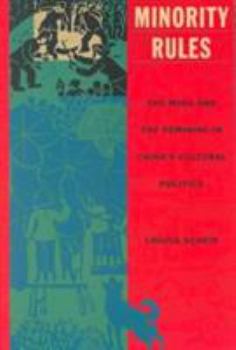Minority Rules: The Miao and the Feminine in China's Cultural Politics
(Part of the Body, Commodity, Text Series)
Select Format
Select Condition 
Book Overview
Minority Rules is an ethnography of a Chinese people known as the Miao, a group long consigned to the remote highlands and considered backward by other Chinese. Now the nation's fifth largest minority, the Miao number nearly eight million people speaking various dialects and spread out over seven provinces. In a theoretically innovative work that combines methods from both anthropology and cultural studies, Louisa Schein examines the ways Miao ethnicity is constructed and reworked by the state, by non-state elites, and by the Miao themselves, all in the context of China's postsocialist reforms and its increasing exchange and fascination with the West. She offers eloquently argued interventions into debates over nationalism, ethnic subjectivity, and the ethnography of the state. Posing questions about gender, cultural politics, and identity, Schein examines how non-Miao people help to create Miao ethnicity by depicting them as both feminized keepers of Chinese tradition and as exotic others against which dominant groups can assert their own modernity. In representing and consuming aspects of their own culture, Miao distance themselves from the idea that they are less than modern. Thus, Schein explains, everyday practices, village rituals, journalistic encounters, and tourism events are not just moments of cultural production but also performances of modernity through which others are made primitive. Schein finds that these moments frequently highlight internal differences among the Miao and demonstrates how not only minorities but more generally peasants and women offer a valuable key to understanding China as it renegotiates its place in the global order.
Format:Paperback
Language:English
ISBN:082232444X
ISBN13:9780822324447
Release Date:February 2000
Publisher:Duke University Press
Length:384 Pages
Weight:1.48 lbs.
Dimensions:1.1" x 6.1" x 9.2"
Customer Reviews
2 ratings
Compelling post-modern ethnography
Published by Thriftbooks.com User , 23 years ago
Throughout the twentieth century, Chinese recognition of and tolerance for ethnic minorities (non-Han) has waxed and waned. Very early in the century, sociologists conducted research on non-Han groups. After the revolution, there were attempts to eliminate minority religious practices, such as shamanism. During the period of industrialization, minority provinces were neglected, and depicted as backward. From the 1980's on, there seems to have been an attempt to capitalize on the existence of minorities by promoting tourism to exotic areas such as Guizhou, where many Miao live. Minorities enjoy some privileges that Han do not, such as larger permissible family size, and some linguistic accommodation in education and book production.Schein makes use of Edward Said's notion of `orientalism,' that process of exotifying representations of other peoples in hegemonic fashion, that serves to privilege the culture of the representer. Orientalism is not solely a practice of Westerners-the urban Han Chinese indulge in `internal orientalism,' producing representations of non-Han minority people, especially of women, in a way that makes them exotic, erotic, infantilized foils to urban Han male selves. Schein documents several instances of this taking place in Xijiang, a large village known as a Miao center. There are also instances of performances of Miao ethnicity in Beijing.Yet the Han are not alone in their portrayal of the Hmong as exotic: Miao performers contribute to this orientalistic portrayal by choreographing performances that seem "ethnic," and some performers have made careers based on these performances. Miao ethnicity becomes constructed under outsider-like gaze even by insiders. The entire process of performing exoticized, feminized portrayals of the Miao serves to reinforce the hierarchies of cultural dominance, in which Han is superior to ethnic minority ethnicity, male is superior to female, urban is superior to rural. Thus, ethnicity is not only performed, but also changed, tinged by the performance.I found this ethnography quite fascinating and informative. I would really be curious what Hmong-American readers might think.
Construction of identity in late modernity
Published by Thriftbooks.com User , 24 years ago
Based on her fieldwork among the Miao, an ethnic minority group in China, Schein describes the process of constructing identity in late modern China. This text is greatly helpful for scholars interested in Chinese history and culture, since it engages deeply with the historical materials, locating the central thesis within historical conjuncture between Chinese modernity and late global capitalism. Here, Schein argues that construction of the Miao as an identity cannot be understood without considering the state policy which liberalizes economic structure, in an attempt to grasp foreign cash flows. The commoditization of the ethnic identity, however, does not only mean that the ethnic group exists only for the economic gain. For those involved, especially for the Miao themselves, the process of claiming the ethnic identity themselves is constituted of contradictory moments. Schein here points to the gendered dimension of this phenomenon, noting that the "image" of the Miao, coveted and sentimentalized by both Chinese majority and foreigners, is, in fact, feminine body. An interesting study. I would like to recommend this book to those interested in learning more about modern China.






